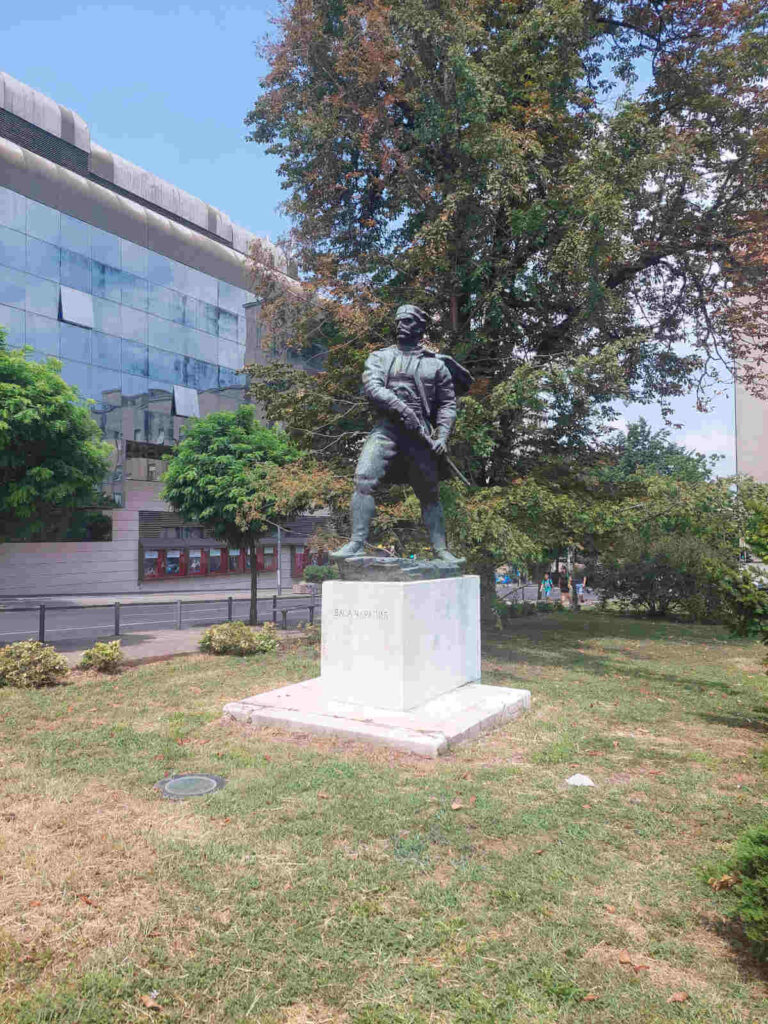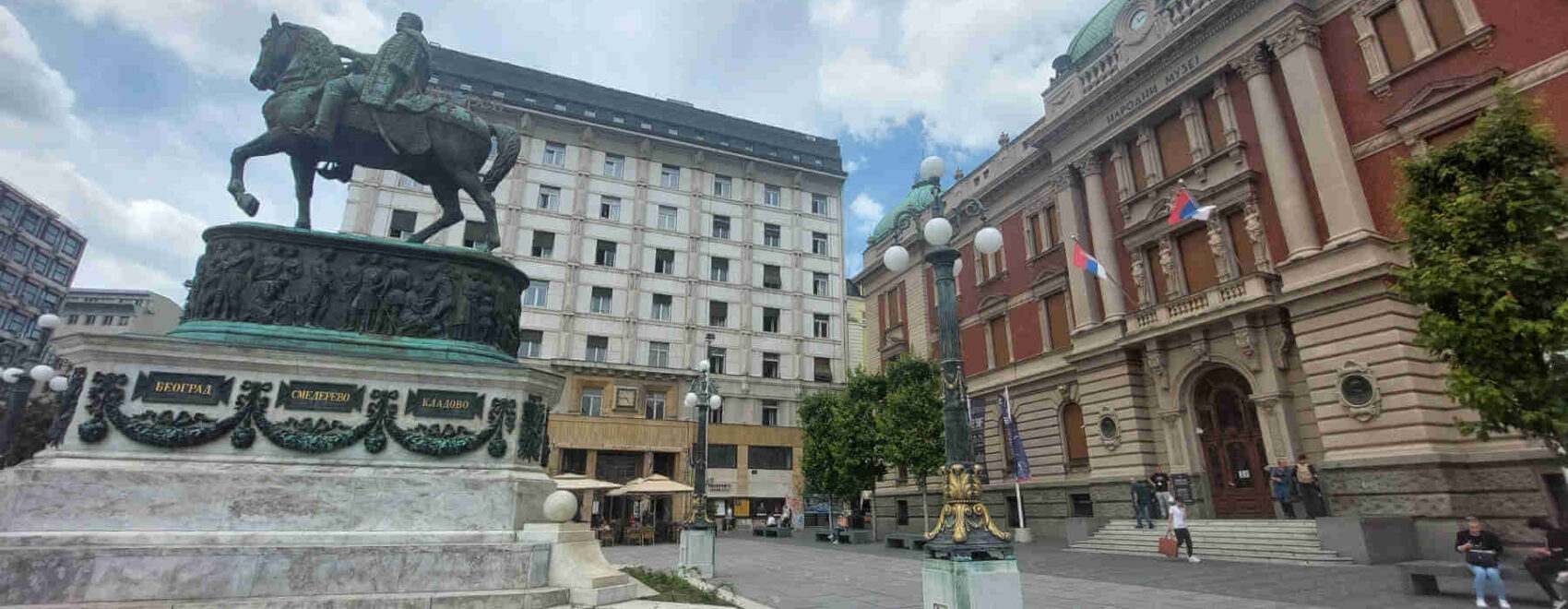Republic Square (Trg republike) stands as the central hub and primary meeting point in Belgrade. Explore the rich history of this iconic location, including its darker chapters during Ottoman rule, uncover its intriguing connection to Istanbul, and delve into its contemporary cultural and social significance.
Table of Contents

Location
Republic Square’s central location makes it a convenient starting point for exploring other attractions in Belgrade.
The square is connected to Belgrade’s bustling pedestrian zone, Knez Mihailova Street. This lively street is lined with shops, cafes, and restaurants, offering a delightful blend of traditional and modern experiences.
The Belgrade Fortress with Kalemegdan Park is just a short walk away, offering panoramic views of the confluence of the Sava and Danube rivers, as well as a glimpse into Belgrade’s rich history.
The nearby Skadarlija district, known as Belgrade’s bohemian quarter, is another must-visit destination. Its cobblestone streets, vibrant cafes, and lively atmosphere provide a charming contrast to the grandeur of Republic Square.
Name
Initially named Theatre Square, it was renamed Republic Square in honor of the proclamation of the Federal People’s Republic of Yugoslavia on November 29, 1945. Despite the subsequent disintegration of Yugoslavia, the square has retained its historic name.

Republic Square Today
The square is the most popular meeting point for citizens, visitors, and tourists in Belgrade, often referred to as “kod konja” (at the horse). This nickname originates from the grand monument of Prince Mihailo on horseback, a distinctive landmark in the square (more details on this monument will follow later in the article). The square is also a bustling venue for a diverse array of events, from festivals and gatherings to protests, concerts, celebrations, and more.
Surrounding Republic Square are some of Belgrade’s most significant architectural landmarks. The National Museum, the building behind the dominant monument, houses an extensive collection of artifacts, ranging from prehistoric relics to contemporary European masterpieces. Across the street is the National Theatre, an architectural gem and cornerstone of Serbian performing arts.

In addition to the buildings of the National Theatre and the National Museum, there is also the so-called Staklenac shopping center, the Riunione Palace, the Press House, as well as numerous bookstores, restaurants, bars, and office spaces.
History of Republic Square: The Stambol Gate and Road to Istanbul
The present-day Republic Square was formed after the demolition of the Stambol Gate in 1866 and the construction of the National Theatre in 1868.

The Stambol Gate, built by the Austrians at the beginning of the 18th century, was located between what would later become the site of the monument to Prince Mihailo and the National Theatre. It was the largest and most beautiful gate during the time when the city was surrounded by a trench, and it was named after the road leading to Istanbul, which passed through it.
Vasa Čarapić, a renowned commander from the First Serbian Uprising against the Ottoman Empire, was mortally wounded in front of this gate in 1806. In his memory, a nearby street was named Vasina Street, and a monument was erected in his honor near the National Theatre, right at the spot where he died.

Near the Stambol Gate, the Turks would impale rebellious Serbs, making the gate infamous among Serbs and a symbol of their suffering under the Ottoman Empire. Consequently, it was demolished in 1866 by the order of Prince Mihailo.
After the establishment of Serbian rule and the demolition of the Stambol Gate, the area of today’s Republic Square remained undeveloped for a long time. For over 30 years, the National Theatre stood as the only significant building. The gradual urban development of the square began after the monument to Prince Mihailo was erected in 1882.

In more recent history, the square is known for the demonstrations of March 27, 1941, the first rally after liberation in 1945, where Josip Broz Tito addressed the people, and numerous protest gatherings that marked the end of the 20th and the beginning of the 21st century.
Prince Mihailo Monument
The centerpiece of Republic Square is the equestrian statue of Prince Mihailo Obrenović, unveiled in 1882. Prince Mihailo, a pivotal figure in Serbian history, is celebrated for his efforts in securing the independence of Serbian cities from Ottoman rule. Created by the renowned Italian sculptor Enrico Pazzi, the statue depicts Prince Mihailo pointing towards the south, symbolizing his unrealized plans for the liberation of all Serbian cities.

The statue of Prince Mihailo Obrenović, the liberator of Serbia from Ottoman rule in 1867, occupies the central part of the square and is one of the most beautiful monuments in Belgrade. The monumental figure of Prince Mihailo on horseback is made of marble and bronze and stands 11 meters high.
The pedestal is inscribed with the names of the cities handed over by the Ottomans in 1867 – Belgrade, Smederevo, Kladovo, Soko, Užice, and Šabac. Other panels on the pedestal depict scenes from Serbian history.
Conclusion

Republic Square is a microcosm of Belgrade itself—a city that has weathered the tides of history and emerged as a vibrant, dynamic metropolis. Its historical significance, architectural marvels, cultural vibrancy, and modern-day allure make it a must-visit destination for anyone seeking to understand the essence of Belgrade. (sources: City of Belgrade, Espreso)


Leave a Reply